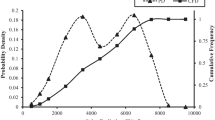Abstract
In this study, moving least squares approach (MLSA) is used for solar radiation (SR) estimation in the selected region. While develo** new models with the MLSA, three different weight functions which are Gaussian, cubic spline and Wendland are used. The compatibility of some modified Angström-type equations were tested to estimate of monthly average daily global SR at selected region. The most suitable equation was found by comparing with the values measured and obtained from the equation. In this paper, six different statistical error analysis tests are used in order to compare the performance of new proposed models. According to the results obtained in the selected region, the weight function for which the best performance values are obtained is the cubic spline weight function.

Similar content being viewed by others
References
Kaplan AG, Kaplan YA (2020) Develo** of the new models in solar radiation estimation with curve fitting based on moving least-squares approximation. Renew Energy 146:2462–2471
Kaplan YA (2018) A new model for predicting the global solar radiation. Environ Prog Sustain Energy 37(2):870–880
Togrul INT, Onat E (2000) A comparison of estimated and measured values of solar radiation in Elazig Turkey. Renew Energy 20(2):243–252
** Z, Yezheng W, Gang Y (2005) General formula for estimation of monthly average daily global solar radiation in China. Energy Convers Manage 46(2):257–268
Menges HO, Ertekin C, Sonmete MH (2006) Evaluation of global solar radiation models for Konya Turkey. Energy Convers Manage 47(18):3149–3173
Zang H, Jiang X, Cheng L, Zhang F, Wei Z, Sun G (2022) Combined empirical and machine learning modeling method for estimation of daily global solar radiation for general meteorological observation stations. Renew Energy 195:795–808
Kaplan YA, Sarac MS, Unaldi GG (2022) Develo** a new model in solar radiation estimation with genetic algorithm method. Environ Prog Sustain Energy 41(6):e13912
Demir V, Citakoglu H (2023) Forecasting of solar radiation using different machine learning approaches. Neural Comput Appl 35(1):887–906
Tey WY, Che Sidik NA, Asako YW, Muhieldeen M, Afshar O (2021) Moving least squares method and its improvement: a concise review. J Appl Comput Mech 7(2):883–889
Degel JP, Hähnlein S, Klöffer C, Doppelbauer M (2020) A moving least-square approach for current slope estimation in an inverter fed IPMSM using field programmable gateway arrays. In: 2020 ınternational conference on electrical machines (ICEM) (vol 1, pp 1033–1039). IEEE
Huang Z, Lei D, Han Z, Lin J (2020) Boundary moving least squares method for 3D elasticity problems. Eng Anal Boundary Elem 121:255–266
Zeng QH, Lu DT (2004) Curve and Surface fitting based on moving least-squares methods. J Eng Graph 1:84–89
Zuo CW, Nie YF, Zhao ML (2005) The selection about the radius of influence in MLS. Chin J Eng Math 21:833–838
Lancaster P, Salkauskas K (1981) Surfaces generated by moving least squares methods. Math Comput 37(155):141–158
Zhang H, Guo C, Su X, Zhu C (2015) Measurement data fitting based on moving least squares method. Math Probl Eng 2015:195023
Kaplan AG, Dereli Y (2017) Numerical solutions of the GEW equation using MLS collocation method. Int J Mod Phys C 28(1):1750011
Wang JF, Bai FN, Cheng YM (2011) A meshless method for the nonlinear generalized regularized long wave equation. Chin Phys B 20(3):030206
Kaplan AG, Dereli Y (2017) A meshless method and stability analysis for the nonlinear Schrödinger equation. Waves Random Complex Media 27(4):602–614
Duffie JA, Beckman WA (2013) Solar engineering of thermal processes. Wiley, New York
Kallioglu MA (2014) Improving a model for calculating daily global diffuse and direct solar radiation on horizontal surfaces for Nigde. Master's thesis, Nigde University Graduate School of Natural and Applied Sciences Department of Mechanical Engineering
Aras H, Balli O, Hepbasli A (2006) Global solar radiation potential, part 2: statistical analysis. Energy Sources Part B-Econ Plann Policy 1(3):317–326
Ulgen K, Hepbasli A (2004) Solar radiation models, part 2: Comparison and develo** new models. Energy Sources 26(5):521–530
Skeiker K (2006) Correlation of global solar radiation with common geographical and meteorological parameters for Damascus province Syria. Energy Convers Manage 47(4):331–345
Oztürk M, Ozek N, Berkama B (2012) Comparison of some existing models for estimating monthly average daily global solar radiation for Isparta. Pamukkale University. J Eng Sci 18(1):13–27
Khorasanizadeh H, Mohammadi K, Mostafaeipour A (2014) Establishing a diffuse solar radiation model for determining the optimum tilt angle of solar surfaces in Tabass Iran. Energy Convers Manage 78:805–814
Sabzpooshani M, Mohammadi K (2014) Establishing new empirical models for predicting monthly mean horizontal diffuse solar radiation in city of Isfahan Iran. Energy 69:571–577
Agbulut U, Gürel AE, Bicen Y (2021) Prediction of daily global solar radiation using different machine learning algorithms: evaluation and comparison. Renew Sustain Energy Rev 135:110114
Fan J, Wu L, Zhang F, Cai H, Ma X, Bai H (2019) Evaluation and development of empirical models for estimating daily and monthly mean daily diffuse horizontal solar radiation for different climatic regions of China. Renew Sustain Energy Rev 105:168–186
Emang D, Shitan M, Abd Ghani AN, Noor KM (2010) Forecasting with univariate time series models: a case of export demand for peninsular Malaysia’s moulding and chipboard. J Sustain Dev 3(3):157
Author information
Authors and Affiliations
Corresponding author
Ethics declarations
Conflict of interest
The author declare that she has no confict of interest.
Additional information
Publisher's Note
Springer Nature remains neutral with regard to jurisdictional claims in published maps and institutional affiliations.
Rights and permissions
Springer Nature or its licensor (e.g. a society or other partner) holds exclusive rights to this article under a publishing agreement with the author(s) or other rightsholder(s); author self-archiving of the accepted manuscript version of this article is solely governed by the terms of such publishing agreement and applicable law.
About this article
Cite this article
Kaplan, A.G. The New Solar Radiation Estimation Models Using Different Weight Functions in the Moving Least Squares Approach. Proc. Natl. Acad. Sci., India, Sect. A Phys. Sci. (2024). https://doi.org/10.1007/s40010-024-00880-0
Received:
Revised:
Accepted:
Published:
DOI: https://doi.org/10.1007/s40010-024-00880-0




